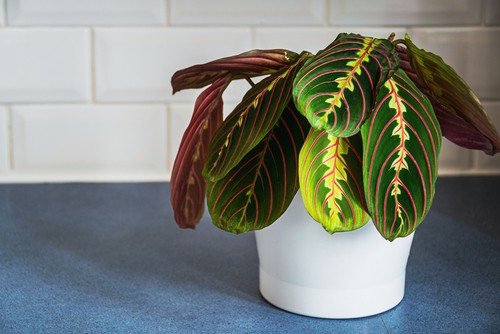Prayer plants are a popular choice for indoor gardeners due to their unique foliage and low maintenance requirements. However, if you notice that your prayer plant have yellow leaves, it could be a sign of an underlying issue. Understanding the causes of yellow leaves on prayer plants is crucial to maintaining their health and appearance.
One of the main reasons for yellow leaves on prayer plants is overwatering. These plants prefer moist but well-draining soil, and too much water can lead to root rot and other issues. Another common cause of yellow leaves is exposure to cold temperatures.
Prayer plants are tropical plants and are sensitive to cold air and drafts. Inadequate light and poor soil conditions can also cause yellow leaves on prayer plants.
Key Takeaways
- Overwatering and cold temperatures are common causes of yellow leaves on prayer plants.
- Proper lighting, soil conditions, and watering practices are crucial for maintaining the health of prayer plants.
- Identifying and treating problems early can prevent further damage to prayer plants.
Related posts:
- Why Does My Monstera Plant Have Water Droplets?
- Why Does My Mint Plant Keep Dying?
- Why Does My Jade Plant Have Black Spots?
Understanding Prayer Plants

Prayer plants, also known as Maranta leuconeura, belong to the Marantaceae family and are native to tropical rainforests in South America. They are known for their striking green foliage with intricate patterns and colors that can add a touch of natural beauty to any indoor space.
Prayer plants are part of a larger group of plants that includes Ctenanthes, Stromanthes, and Calatheas. These plants are all known for their unique foliage and sensitivity to environmental changes.
One of the most distinctive features of prayer plants is their ability to move their leaves. At night, the leaves fold up as if in prayer, which is where the plant gets its common name. During the day, the leaves unfurl to capture sunlight and promote photosynthesis.
Prayer plants are relatively easy to care for, but they do have specific requirements. They prefer bright, indirect light and well-draining soil that is kept consistently moist but not waterlogged. They are also sensitive to temperature changes and should be kept in a warm, humid environment.
If a prayer plant is not receiving the proper care, it may develop yellow leaves. This can be a sign of environmental stress, such as exposure to cold temperatures or overwatering. Pests and diseases can also cause yellowing leaves.
Understanding the unique characteristics and needs of prayer plants can help you provide the best care for your plant and prevent issues like yellow leaves from developing.
The Role of Light
1. Sunlight and Prayer Plants
Light is an essential factor in the growth of plants, and the prayer plant is no exception. Prayer plants require bright, indirect light to thrive. They are native to the forest floors of tropical regions, where they grow under the canopy of trees and receive filtered sunlight.
2. Effects of Direct Sunlight
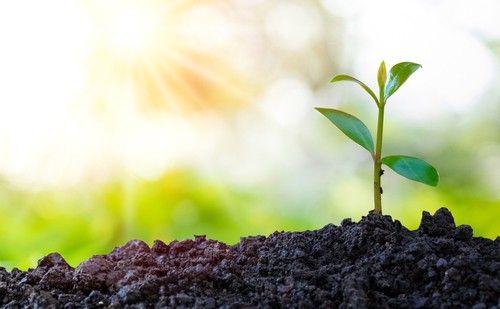
Direct sunlight can harm the leaves of prayer plants, causing them to turn yellow. When prayer plants are exposed to too much direct sunlight, the leaves can burn and dry out. This can cause the plant to become stressed, leading to yellowing of the leaves.
3. Ideal Lighting Conditions
The ideal lighting conditions for prayer plants are bright, indirect light. North-facing rooms are ideal because they receive the least amount of direct sunlight. However, if your prayer plant is in a south-facing room, it is essential to filter the light. You can do this by placing the plant near a sheer curtain or by using a shade cloth.
It is also important to note that prayer plants can become stressed if they are exposed to sudden changes in lighting conditions. For example, if you move your prayer plant from a low-light area to a bright, sunny area, the leaves may turn yellow.
Watering Needs and Issues
Proper watering is crucial for the health of prayer plants. Overwatering or underwatering can cause yellowing of the leaves.
1. Overwatering Problems
Overwatering is one of the most common reasons for yellow leaves in prayer plants. When a plant is overwatered, the roots become waterlogged, and the plant cannot absorb nutrients properly. This can lead to yellowing of the leaves, as well as root rot and other fungal diseases.
To avoid overwatering, make sure the soil is well-draining and that the pot has drainage holes. Avoid letting the plant sit in standing water, which can cause the roots to suffocate. If the soil feels moist, wait until it dries out before watering again.
2. Underwatering Signs
Underwatering can also cause yellow leaves in prayer plants. When a plant is not watered enough, it cannot absorb nutrients properly, and the leaves may turn yellow and wilt.
To avoid underwatering, make sure the soil is consistently moist but not waterlogged. Check the soil regularly and water the plant when the top inch of soil feels dry.
3. Ideal Watering Techniques
The ideal watering technique for prayer plants is to water thoroughly and then allow the soil to dry out slightly before watering again. Use distilled water or rainwater if possible, as tap water can contain minerals that can build up in the soil and damage the plant.
When watering, make sure to water at the base of the plant and avoid getting water on the leaves, which can cause fungal diseases. It’s also important to use a pot that is the right size for the plant, as a pot that is too large can hold too much water and lead to overwatering.
By following these watering tips, you can help keep your prayer plant healthy and prevent yellow leaves.
Soil and Fertilizer Requirements
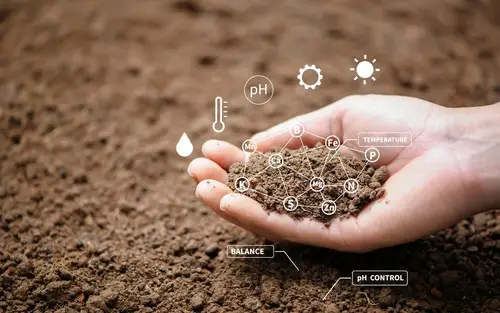
Choosing the Right Soil
Prayer plants require well-draining soil that is rich in organic matter. A good potting mix should contain a combination of peat moss, sand, and perlite to ensure proper drainage. It is also important to choose a potting medium with a pH between 6.0 and 6.5, which is slightly acidic.
Fertilizer Use and Misuse
Fertilizer is essential for the growth and health of prayer plants, but over-fertilizing can cause yellowing of the leaves. It is important to follow the instructions on the fertilizer package and not exceed the recommended amount.
Overuse of fertilizer can lead to the buildup of fertilizer salts in the soil, which can burn the roots of the plant.
Prayer plants should be fertilized every two weeks during the growing season, which is typically from spring to fall. A balanced fertilizer with equal amounts of nitrogen, phosphorus, and potassium can be used to promote healthy growth. It is important to avoid fertilizing during the winter months when the plant is dormant.
Coconut coir can also be used as a potting medium for prayer plants. It is a sustainable alternative to peat moss and has excellent water retention properties. However, it is important to note that coconut coir has a high pH and may need to be mixed with other materials to achieve the optimal pH range for prayer plants.
Effects of Environment and Temperature
Prayer plants are sensitive to environmental factors, and the wrong conditions can cause their leaves to turn yellow. In this section, we will discuss how humidity and temperature affect prayer plants.
Humidity and Prayer Plants
Prayer plants are native to tropical regions, and they thrive in warm, humid environments. Low humidity can cause the leaves of prayer plants to turn yellow and drop off. If the air in your home is dry, you can use a humidifier to increase the humidity around your prayer plant.
Alternatively, you can place a tray of water near your plant to increase the relative humidity.
On the other hand, if the humidity is too high, your prayer plant may develop fungal diseases. To prevent this, make sure that your plant is not overwatered, and avoid misting the leaves too frequently.
Insufficient humidity can also cause the leaves of your prayer plant to dry out and turn yellow, so make sure that the air around your plant is moist enough.
Temperature Factors

Prayer plants prefer warm temperatures between 65 and 75 degrees Fahrenheit. High temperatures can cause the leaves of your prayer plant to turn yellow and wilt. If your prayer plant is exposed to direct sunlight or placed near a heating system, it may become too hot.
To prevent this, move your plant to a cooler location or shade it from direct sunlight.
Cold drafts can also damage your prayer plant and cause its leaves to turn yellow. Make sure that your plant is not placed near a window or door that is frequently opened. If your prayer plant is exposed to cool temperatures, it may also become more susceptible to pests and diseases.
Common Diseases and Pests
Identifying Diseases
Yellow leaves on prayer plants can be a sign of diseases caused by fungi, bacteria, or viruses. Helminthosporium leaf spot is a common fungal disease that causes yellow spots on the leaves.
Cucumber mosaic virus is another viral disease that can cause yellowing of the leaves. If the leaves have brown or black spots, it could be a sign of leaf spot disease.
Root rot is a fungal disease that can cause yellowing of the leaves. It is caused by overwatering or poor drainage. If the roots are brown, mushy, and emit a foul odor, it is a sign of root rot.
Dealing with Pests
Pests such as mealybugs can also cause yellowing of the leaves. These pests suck the sap from the leaves, causing them to turn yellow and eventually fall off. Neem oil is an effective organic pesticide that can be used to get rid of mealybugs.
If the prayer plant is exposed to too much fluoride, it can also cause yellowing of the leaves. To deal with fluoride toxicity, it is important to use distilled water or rainwater for watering the plant.
Fungal diseases can be treated with a fungicide. It is important to identify the specific fungus causing the disease and use the appropriate fungicide. For example, helminthosporium leaf spot can be treated with a copper-based fungicide.
Identifying and Treating Problems

When a prayer plant develops yellow or brown leaves, it is often a sign of an underlying problem. In this section, we will discuss how to diagnose and treat these issues.
1. Yellow and Brown Leaves
Yellow leaves on a prayer plant can be caused by a variety of factors, including overwatering, underwatering, excess sunlight, and nutrient deficiencies. One common cause of yellowing leaves is chlorosis, which occurs when the plant is not able to produce enough chlorophyll due to a lack of iron or other nutrients.
To diagnose the issue, check the soil moisture level and adjust watering accordingly. If the soil is too dry, increase watering frequency. If the soil is too wet, reduce watering frequency or improve drainage.
Additionally, consider adjusting the plant’s exposure to sunlight and fertilizing with a balanced fertilizer to provide the necessary nutrients.
Brown leaves on a prayer plant can be caused by similar factors as yellowing leaves. However, brown leaves are often a sign that the problem has progressed further and may be more difficult to treat. In some cases, brown leaves may need to be trimmed off to prevent further damage to the plant.
2. Scorch Marks and Spots
Scorch marks and spots on prayer plant leaves can be caused by excess sunlight, pests, or diseases. If the plant is receiving too much direct sunlight, move it to a shadier location or provide shade using a sheer curtain or shade cloth.
If pests or diseases are present, identify the specific issue and treat accordingly. Some common pests that affect prayer plants include spider mites, mealybugs, and scale insects. Diseases that may cause scorch marks and spots include leaf spot and powdery mildew.
3. Wilting and Poor Growth
Wilting and poor growth on a prayer plant can be caused by a lack of water, excess water, or root rot. To diagnose the issue, check the soil moisture level and adjust watering accordingly. If the soil is too dry, increase watering frequency. If the soil is too wet, reduce watering frequency or improve drainage.
If root rot is suspected, carefully remove the plant from its pot and inspect the roots. If the roots are brown, mushy, or have a foul odor, they may be rotting. In this case, trim away any damaged roots and repot the plant in fresh, well-draining soil.
Proper Care and Maintenance
1. Repotting and Drainage
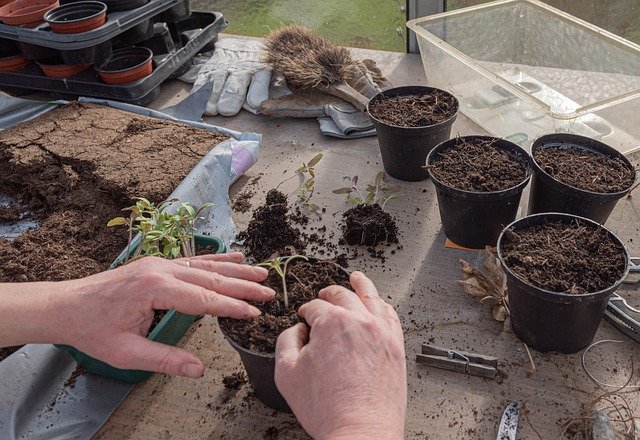
Prayer plants prefer to be root-bound, so it’s best to only repot them when necessary. When it is time to repot, choose a pot that is only slightly larger than the current one. Make sure the new pot has drainage holes to prevent water from accumulating at the bottom, which can cause root rot.
When repotting, use a well-draining soil mix that is rich in organic matter. A good mix is equal parts peat moss, perlite, and vermiculite. Fill the bottom of the pot with a layer of gravel or broken pottery to improve drainage.
2. Promoting New Growth
To promote new growth, keep the soil moist but not waterlogged. Water the plant when the top inch of soil is dry to the touch. Avoid using hard water, which can cause mineral buildup in the soil.
Prayer plants prefer bright, indirect light. They can tolerate low light but will not grow as well. Rotate the plant every few weeks to ensure even growth.
Fertilize the plant every two weeks during the growing season with a balanced fertilizer. Reduce fertilization during the winter months when the plant is dormant.
3. Seasonal Care Tips
Prayer plants are tropical plants and prefer warm temperatures between 65°F and 80°F. Keep the plant away from drafts and cold windows during the winter months.
During the growing season, the plant will benefit from increased humidity. Mist the leaves with water or place a tray of water near the plant to increase humidity.
In the winter, reduce watering and fertilization as the plant goes into dormancy. The leaves may turn yellow during this time, which is normal. Reduce watering to once a month and stop fertilization until the plant begins to grow again in the spring.
Note: This article may contain affiliate links to products. The author may receive a commission for purchases made through these links.
Why Your Prayer Plant Have Yellow Leaves – 3 Common Problems
1. Incorrect Watering
One of the most common mistakes that people make with their prayer plants is incorrect watering. Overwatering can lead to root rot, which can cause yellowing of the leaves. On the other hand, underwatering can cause the leaves to dry out and turn yellow.
To avoid overwatering, make sure that the soil is well-draining and that the pot has drainage holes. Water the plant only when the top inch of soil is dry to the touch. To avoid underwatering, make sure that the soil is moist but not waterlogged.
2. Poor Lighting Conditions
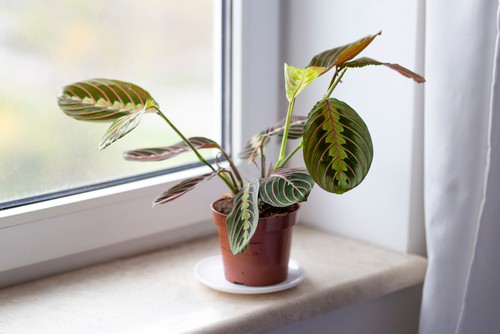
Prayer plants require bright, indirect light to thrive. If they are exposed to too much direct sunlight, the leaves can become scorched and turn yellow. On the other hand, if they are kept in low light conditions, the leaves can become pale and yellow.
To avoid poor lighting conditions, make sure that the plant is placed in a bright, but indirect light. If the plant is exposed to direct sunlight, move it to a shadier spot. If the plant is kept in low light conditions, consider using artificial light to supplement the natural light.
3. Inadequate Soil and Fertilizer
Prayer plants require well-draining soil that is rich in organic matter. If the soil is too compacted or lacks nutrients, the plant may develop yellow leaves. In addition, if the plant is not fertilized regularly, it may develop nutrient deficiencies, which can cause yellowing of the leaves.
To avoid inadequate soil and fertilizer, make sure that the soil is well-draining and rich in organic matter. Consider using a balanced fertilizer that is high in nitrogen, phosphorus, and potassium. Fertilize the plant every two weeks during the growing season and once a month during the dormant season.
By avoiding these common mistakes, you can help your prayer plant stay healthy and vibrant.
Frequently Asked Questions
What to do when prayer plant leaves turn yellow?
When prayer plant leaves turn yellow, it’s usually a sign of environmental stress or disease. The first step is to identify the cause of the problem. Some common causes include overwatering, underwatering, exposure to cold temperatures, insufficient humidity, and nutrient deficiencies.
Once you’ve identified the cause, take steps to correct it. For example, if your plant is overwatered, let the soil dry out before watering again. If the problem is low humidity, mist your plant regularly or use a humidifier.
What does yellow leaves on a prayer plant mean?
Yellow leaves on a prayer plant can mean a variety of things, including environmental stress, disease, or pest infestation. If the yellowing is widespread, it’s likely a sign of environmental stress.
If the yellowing is localized, it could be a sign of disease or pest infestation. In any case, it’s important to identify the cause of the problem and take action to correct it.
How often should I water my prayer plant?
Prayer plants prefer to be kept consistently moist but not waterlogged. As a general rule, water your plant when the top inch of soil feels dry to the touch. Be sure to use a well-draining potting mix and a pot with drainage holes to prevent water from accumulating in the soil.
What do I do when my prayer plant leaves turn yellow?
When your prayer plant leaves turn yellow, the first step is to identify the cause of the problem. Once you’ve identified the cause, take steps to correct it. For example, if the problem is overwatering, let the soil dry out before watering again.
If the problem is low humidity, mist your plant regularly or use a humidifier. If the problem is pest infestation or disease, treat your plant with an appropriate insecticide or fungicide.
Should I cut off yellow leaves from my prayer plant?
Yes, you should cut off yellow leaves from your prayer plant. Yellow leaves are a sign of stress or disease, and removing them can help prevent the problem from spreading to other parts of the plant.
Use clean, sharp scissors or pruning shears to make a clean cut just above the base of the leaf stem.
Why is my prayer plant turning yellow?
There are many possible reasons why your prayer plant is turning yellow, including environmental stress, disease, or pest infestation.
Some common causes include overwatering, underwatering, exposure to cold temperatures, insufficient humidity, and nutrient deficiencies. The first step is to identify the cause of the problem and take steps to correct it.

Hey, I’m Lisa and I’ve been an avid gardener for over 30 years. I love writing, talking and living in the garden! Feel free to connect with me on my socials below

